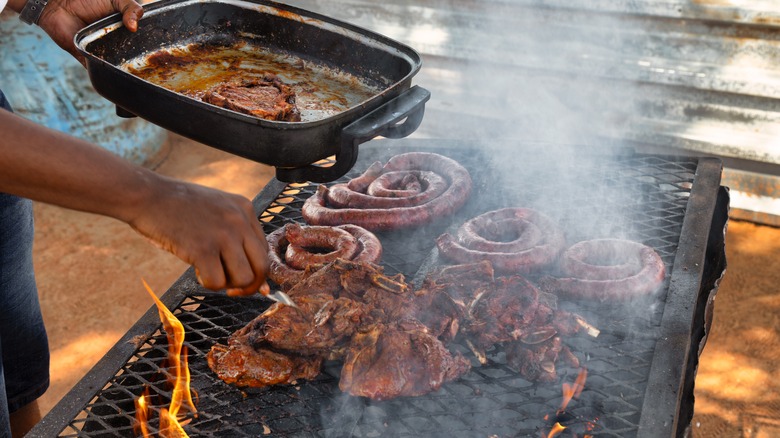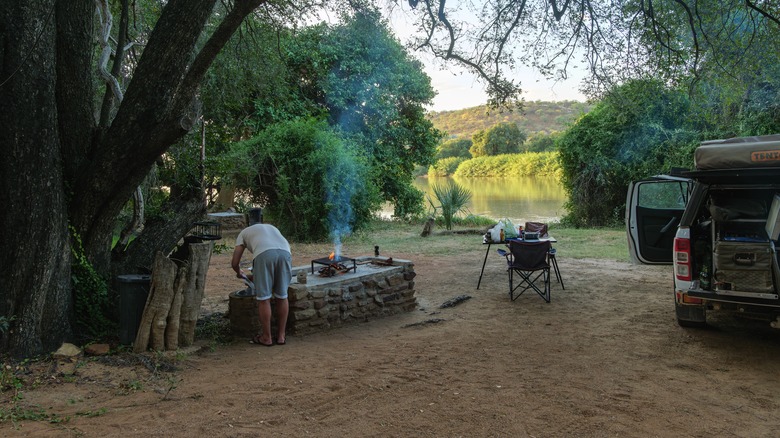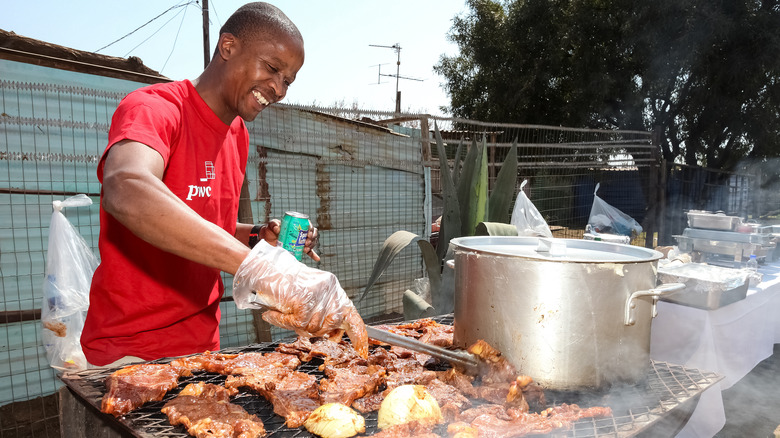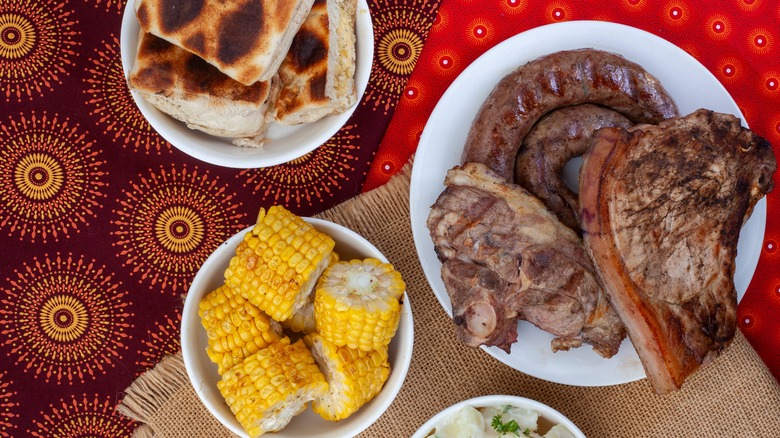Braai Is The South African BBQ Everyone Should Try Once In Their Life
It's hard to top open-fire cooking when you're looking to prepare a meal worthy of an occasion. Loved ones gather around a hot and warming flame, wait until the fire subsides, and then throw on a range of sizzling meats and vegetables. It's a beautiful ritual that's brought people together for centuries — after all, cooking over fire is the earliest style of cooking. It's unsurprising that varying types of barbecue exist world-wide, with each style having its unique traditions and ingredients.
In South Africa, the local style of barbecue is called braai and is a frequent occasion that's especially communal. It's a casual outing that's social and long-lasting, involving a broad selection of meats, sides, condiments and drinks. So in order for the event to run its relaxing course, there are a few established rituals. A single person– called a braaimaster — directs the whole operation, with others forbidden from tending the fire. Guests pitch in with ingredients and socialize, laying the foundation for a beautiful barbecue experience.
The tradition of braai carries cultural importance in South Africa
This slow-cooking style fuses centuries-old traditions, with its roots tracing to indigenous methods practiced in the country. The word braai is Afrikaans — it translates to barbecue — and stems from the Dutch word for grilled meat. So just like in its lingual legacy, the style of cooking incorporates a touch of European influence, too.
However, braai has now evolved into a distinctly South African experience that's a cherished part of the country's culinary and cultural identity. It's a social affair that brings together communities, a quality that was witnessed profoundly during apartheid. During this time, Black citizens were banned from conducting braai in public spaces, so they took to private spaces to uphold their cultural traditions. With the election of Nelson Mandela, braai took on a cherished celebratory note, and is now a staple on South African Heritage Day, held on September 24th. In addition to this national holiday, braai is also commonplace on birthdays, engagements, and other notable events in South Africa.
Braai is conducted with a specific ritual
Braai takes place both in public areas and in backyards; unlike American barbecue, there aren't commercial eateries specializing in braai. Instead, it's a gathering that comes with a specific ritual. Someone volunteers as braai master, and a specific meeting point is arranged. The person in charge dictates how the cooking process will be carried out, and it's considered rude to intervene. Instead, guests are expected to bring meat to pitch in, as well as snacks and drinks. The braai master typically pre-marinates some of the protein and tends to the grill and fire. Customs differ per braai, so it's paramount to maintain communication with the host prior to the event.
Braai is an elongated affair that starts in the early afternoon and ends late at night. As a result, another necessity is to not arrive hungry. To start, there are often small appetizers like biltong, a jerky-like food, but not too many substantial foodstuffs. So rather than arriving at the braai and immediately dining, there's an element of waiting and socializing while the fire's prepared. Drawing out the proceedings prior to eating is a large part of the event's appeal.
Braai involves an extensive selections of meats and sides
When it comes to the food, braai is a wondrously open-ended barbecue style. Cooking is typically conducted over a wood fired pit, sometimes on charcoal, and never on gas. The employed logs encompass a wide range of local wood. With every guest contributing some ingredients to the braai, the flavors will vary.
Common candidates include boerewors, a type of sausage comprised of pork and beef, as well as spiced farmer's sausage. You'll often see skewered meats called sosaties, which are typically made with lamb marinated in a fragrant curry. And a braai might also include heartier cuts like lamb chops, steaks, and pork, as well as ostrich steaks, springbok, chicken and seafood, all marinated in herbs and spices. If there's a type of meat that catches the eye, it's acceptable to bring to a braai.
However, the fare doesn't stop there; there are also numerous sides to enjoy. Pap, a maize porridge, is likely to hit the table, as well as braaibroodjie, a grilled cheese-like sandwich stuffed with chutney and toasted on the grill. And for more bright dashes of flavors, guests bring homemade condiments like chakalaka, a vegetable relish, piri-piri sauce, and other chutneys. Since the fire takes time to get going, the experience starts with drinks, which include beer, wine, and brandy. Such a delicious spread means a great time is guaranteed and you won't be leaving hungry.



